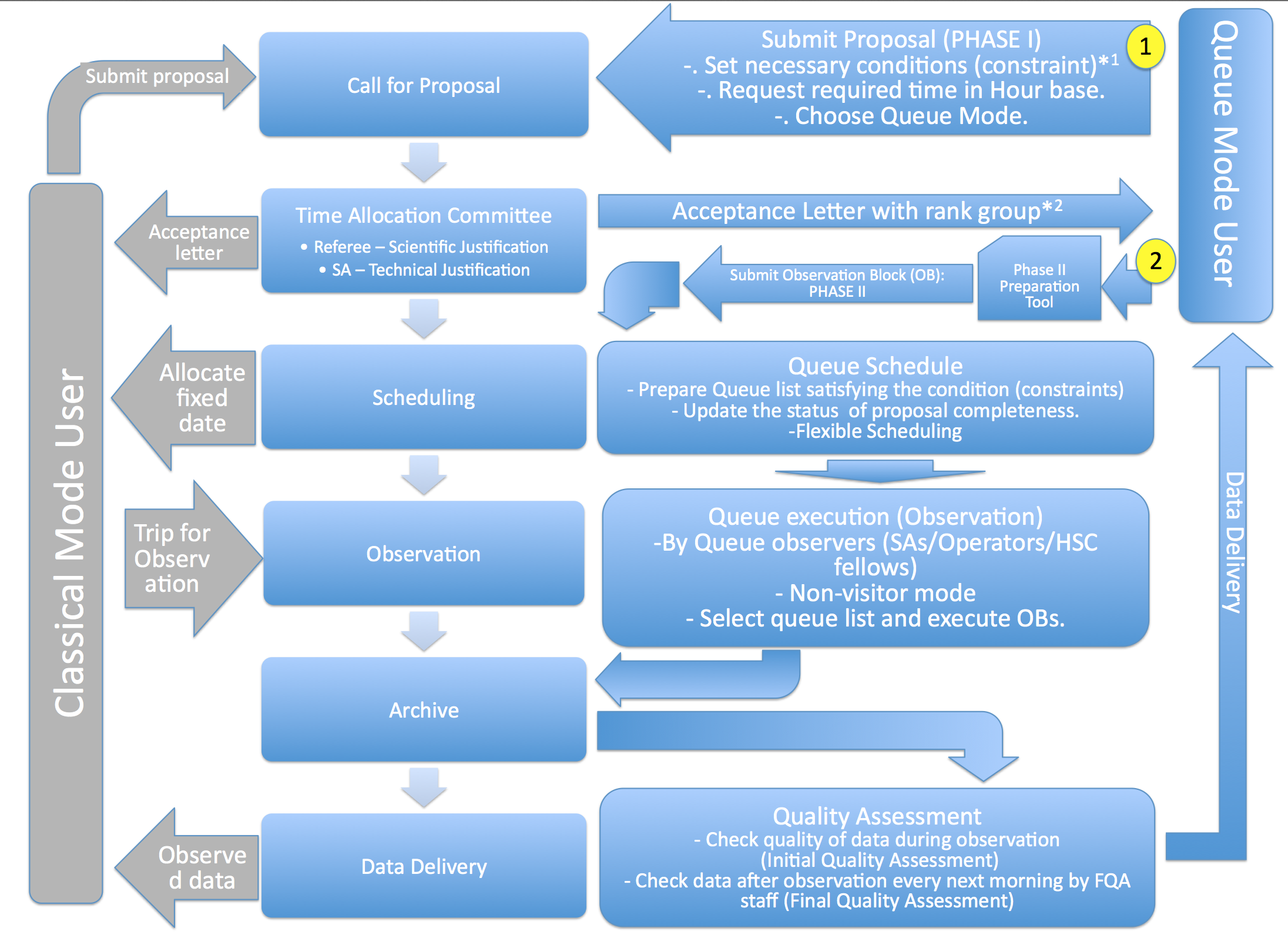General information
Hyper Suprime-Cam
Hyper Suprime-Cam (HSC) is a gigantic mosaic CCD camera, which is installed at the prime focus of Subaru Telescope. HSC uses 104 main science CCDs, which cover a FoV of 1.5 deg in diameter, with a pixel scale of 0.17", as well as 4 CCDs for auto guider, and 8 CCDs for focus monitoring. Information about the instrument can be found at:
https://www.naoj.org/Instruments/HSC/index.html
We recommend prospective PIs read the instrument information above first. For each observing run a set of filters is selected, and observations are performed using only those. Due to the construction of the instrument, changing filters during the night is time-consuming and is not frequently carried out.
The HSC pipeline
There is a dedicated data reduction pipeline for HSC. For download, installation and usage instructions go to:
https://hsc.mtk.nao.ac.jp/pipedoc/pipedoc_8_e/index.html.
Please note that it is possible to use the pipeline on one of the machines available locally. For details, see:
https://hsc.mtk.nao.ac.jp/pipedoc/pipedoc_8_e/install_env_e/env.html.
What is queue mode?
Queue mode (QM) is a type of telescope operation, where the observations are carried out by the telescope and instrument operators, without a direct involvement of investigators (PI or Co-I). Targets are selected from a number of approved programs, on the basis of various criteria, such as: the rank of the program, the priority of the target, observing conditions (seeing, sky transparency, humidity, moon phase and distance), air mass, telescope slewing time, current telescope configuration, etc. The main differences from the classical mode are that the PI and Co-Is are not present during the observations (at the summit, nor remotely), and objects from various programs can be selected for a given night. Observations for a given program can be done any time during the whole run allocated for the QM. Higher priority is given to higher-ranked programs, and the observations are carried out in conditions that are required by the PIs. The observing procedure is standardized, which ensures uniformity of all the data. Appropriate selection of objects allows to increase the effective time spent on target, thanks to reduced telescope slewing time and possibility of choosing programs that do not require certain strict criteria (for example, allow for worse seeing or sky transparency). The amount of data and scientific outcome of QM observations is thus typically higher than of the classical mode.
The difference when compared to the Subaru Telescope Service Program observations, available for some of the instruments (see Subaru Service Program), but not for HSC, is that the service programs have fixed allocation of typically 0.5n, so their execution is dependent on many factors (like weather). Approved QM programs are executed during few runs, lasting in total at least several nights, thus there is more flexibility in observations and the probability of having the best-ranked proposals completed is much higher.
Queue operations are divided into several parts:
-
Phase 1 preparation: proposal submission (incl. target selection, telescope configuration, constraints setting, etc.).
-
Phase 2 preparation: observing blocks submission (detailed description of the observations).
-
Observations (execution of the observing blocks) and quality assessment (check if the data meet the proposal criteria).
-
Data delivery (incl. raw science data, calibrations, logs).
This document describes these steps in more details. In case there are
unanswered questions regarding the HSC QM please contact
![]() ,
or go to the QM website for more up-to-date information:
,
or go to the QM website for more up-to-date information:
https://www.naoj.org/Observing/queue/.
Acronyms and terminology
AL – acceptance letter
BBF – broad band filter
CfP – call for proposals
Constraints – observing constraints, limitations on seeing, sky transparency, moon phase, moon distance, air mass
GRADE – Priority level of the HSC queue mode proposal
Filler – type of programs intended for bad weather conditions
FC – finding chart
FQA – final quality assessment
HSC – Hyper Suprime-Cam
IQA – initial quality assessment
NBF – narrow band filter
OB – observing block
Partner – University of Hawaii, Gemini Observatory or Keck Observatory
Phase 1 – period of proposal preparation and submission
Phase 2 – period of OB preparation and submission
PI – Principal Investigator, a person responsible for proposal and OB preparation and submission
QM – queue mode
QO – queue observer, a Subaru Telescope staff member who operates the telescope or instrument at QM night
QWG – queue mode working group
Run – period of time when HSC is attached to the telescope
SA – support astronomer, a person who is supporting HSC operations
SNR – S/N ratio, signal-to-noise ratio
SOD – Science Operation Division
SSP – Subaru Strategic Program
Sukima – “dead time”, classical night time without any observable targets
TAC – time allocation committee
TO – telescope operator
